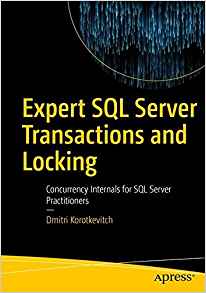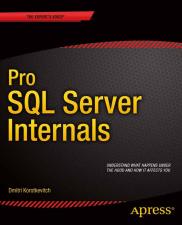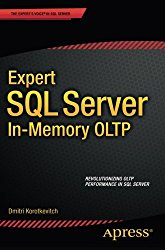Article(s):
Books:
Expert SQL Server Transaction and Locking – covers all versions of SQL Server
Table of Content:
- Chapter 1: Data Storage and Access Methods
- Chapter 2: Transaction Management and Concurrency Models
- Chapter 3: Lock Types
- Chapter 4: Blocking in the System
- Chapter 5: Deadlocks
- Chapter 6: Optimistic Isolation Levels
- Chapter 7: Lock Escalation
- Chapter 8: Schema and Low-Priority Locks
- Chapter 9: Lock Partitioning
- Chapter 10: Application Locks
- Chapter 11: Designing Transaction Strategy
- Chapter 12: Troubleshooting Concurrency Issues
- Chapter 13: In-Memory OLTP Concurrency Model
- Chapter 14: Locking and Columnstore Indexes
Pro SQL Server Internals 2nd Edition – covers SQL Server 2005-2016
- Companion Materials (SQL Scripts and .Net code)
Table of Content:
Part 1 – Tables and Indexes
• Chapter 1: Data storage internals
• Chapter 2: Tables and Indexes – Internal Structure and Access Methods
• Chapter 3: Statistics
• Chapter 4: Special Indexing and Storage Features
• Chapter 5: SQL Server 2016 Features
• Chapter 6: Index fragmentation
• Chapter 7: Designing and tuning the indexes
Part 2: Other things that matter
• Chapter 8: Constraints
• Chapter 9: Triggers
• Chapter 10: Views
• Chapter 11: Functions
• Chapter 12: XML and JSON
• Chapter 13: Temporary Objects and TempDB
• Chapter 14: CLR
• Chapter 15: CLR types
• Chapter 16: Data partitioning
Part 3: Locking, Blocking and Concurrency
• Chapter 17: Lock types
• Chapter 18: Troubleshooting Blocking issues
• Chapter 19: Deadlocks
• Chapter 20: Lock Escalations
• Chapter 21: Optimistic isolation levels
• Chapter 22: Application locks
• Chapter 23: Schema locks
• Chapter 24: Designing transaction strategies
Part 4: Query Life Cycle
• Chapter 25: Query Optimization and Execution
• Chapter 26: Plan Caching
Part 5: Practical Troubleshooting
• Chapter 27: Extended events
• Chapter 28: System Troubleshooting
• Chapter 29: Query Store
Part 6: Inside the transaction log
• Chapter 30: Transaction Log Internals
• Chapter 31: Backup and Restore
• Chapter 32: High Availability Strategies
Part 7: Columnstore Indexes
• Chapter 33: Column-Based Storage and Batch-Mode Execution
• Chapter 34: Columnstore indexes
Part 8: In-Memory OLTP Engine
• Chapter 35: In-Memory OLTP Internals
• Chapter 36: Transaction Processing in In-Memory OLTP
• Chapter 37: In-Memory OLTP Programmability
Expert SQL Server In-Memory OLTP 2nd Edition – Deep dive into In-Memory OLTP in SQL Server 2016 and beyond.
Table of Content:
• Chapter 1: Why In-Memory OLTP?
• Chapter 2: In-Memory OLTP Objects
• Chapter 3: Memory-Optimized Tables
• Chapter 4: Hash Indexes
• Chapter 5: Nonclustered Indexes
• Chapter 6: Memory Consumers and Off-Row Storage
• Chapter 7: Columnstore Indexes
• Chapter 8: Transaction Processing in In-Memory OLTP
• Chapter 9: In-Memory OLTP Programmability
• Chapter 10: Data Storage, Logging and Recovery
• Chapter 11: Garbage Collection
• Chapter 12: Deployment and Management
• Chapter 13: Utilizing In-Memory OLTP
• Appendix A: Memory-Pointers Management
• Appendix B: Page Splitting and Page Merging in Nonclustered Indexes
• Appendix C: Analyzing the States of Checkpoint File Pairs
• Appendix D: In-Memory OLTP Migration Tools
Pro SQL Server Internals – covers SQL Server 2005-2014.
-
- Companion Materials (SQL Scripts and .Net code)
Table of Content:
Part 1 – Tables and Indexes
• Chapter 1: Data storage internals
• Chapter 2: Tables and Indexes – Internal Structure and Access Methods
• Chapter 3: Statistics
• Chapter 4: Special Indexing and Storage Features
• Chapter 5: Index fragmentation
• Chapter 6: Designing and tuning the indexes
Part 2: Other things that matter
• Chapter 7: Constraints
• Chapter 8: Triggers
• Chapter 9: Views
• Chapter 10: Functions
• Chapter 11: XML
• Chapter 12: Temporary Tables
• Chapter 13: CLR
• Chapter 14: CLR types
• Chapter 15: Data partitioning
• Chapter 16: System design considerations
Part 3: Locking, Blocking and Concurrency
• Chapter 17: Lock types
• Chapter 18: Troubleshooting Blocking issues
• Chapter 19: Deadlocks
• Chapter 20: Lock Escalations
• Chapter 21: Optimistic isolation levels
• Chapter 22: Application locks
• Chapter 23: Schema locks
• Chapter 24: Designing transaction strategies
Part 4: Query Life Cycle
• Chapter 25: Query Optimization and Execution
• Chapter 26: Plan Caching
Part 5: Practical Troubleshooting
• Chapter 27: System Troubleshooting
• Chapter 28: Extended events
Part 6: Inside the transaction log
• Chapter 29: Transaction Log Internals
• Chapter 30: Designing a Backup Strategy
• Chapter 31: Designing a High Availability Strategy
Part 7: In-Memory OLTP Engine
• Chapter 32: Hekaton (In Memory OLTP Engine)
• Chapter 33: In-Memory OLTP Programmability
Part 8: Columnstore Indexes
• Chapter 34: Introduction to Columnstore indexes
• Chapter 35: Clustered Columnstore indexes
Expert SQL Server In-Memory OLTP – Deep dive into In-Memory OLTP in SQL Server 2014.
Table of Content:
• Chapter 1: Why In-Memory OLTP?
• Chapter 2: In-Memory OLTP Objects
• Chapter 3: Memory-Optimized Tables
• Chapter 4: Hash Indexes
• Chapter 5: Nonclustered Indexes
• Chapter 6: In-Memory OLTP Programmability
• Chapter 7: In-Memory OLTP Concurrency Model
• Chapter 8: Data Storage, Logging and Recovery
• Chapter 9: Garbage Collection
• Chapter 10: Deployment and Management
• Chapter 11: Utilizing In-Memory OLTP
• Appendix A: Memory-Pointers Management
• Appendix B: Page Splitting and Page Merging in Nonclustered Indexes
• Appendix C: Analyzing the States of Checkpoint File Pairs
• Appendix D: In-Memory OLTP Migration Tools





Thanks for the time and care you took in writing this book. I enjoyed it immensely and learnt a fair amount.
Thank you very much, Susana! I’m glad that you like it!
Please do not hesitate to contact me if you have any questions.
Sincerely,
Dmitri
Abundantly knowledgeable and comprehensive presentable contain. Highly recommended for all MS SQL DBAs.
Pingback: Schema changes and row size | SELECT STUFF FROM SQL